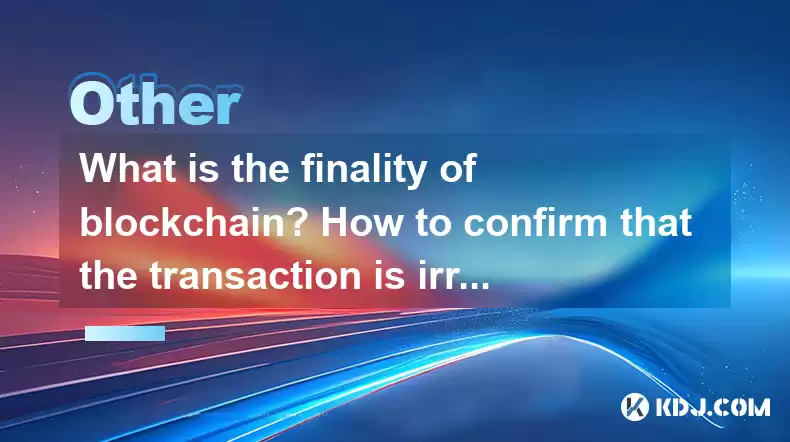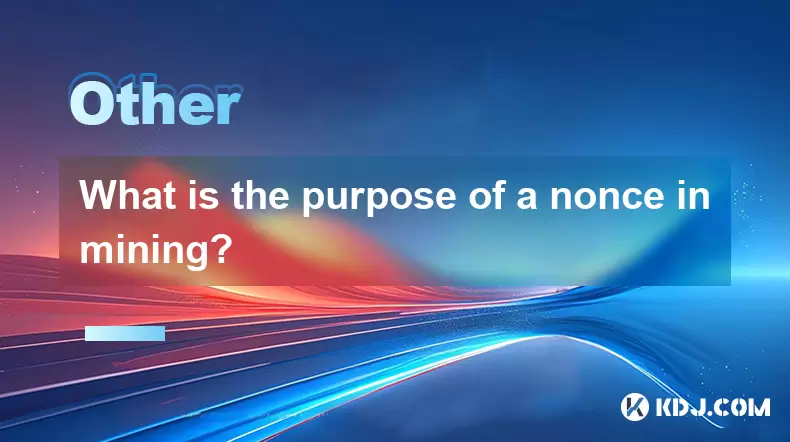-
 Bitcoin
Bitcoin $114400
0.68% -
 Ethereum
Ethereum $3550
2.48% -
 XRP
XRP $3.001
4.99% -
 Tether USDt
Tether USDt $0.9999
0.01% -
 BNB
BNB $757.6
1.46% -
 Solana
Solana $162.9
1.07% -
 USDC
USDC $0.9998
0.00% -
 TRON
TRON $0.3294
0.91% -
 Dogecoin
Dogecoin $0.2015
2.46% -
 Cardano
Cardano $0.7379
2.01% -
 Stellar
Stellar $0.4141
8.83% -
 Hyperliquid
Hyperliquid $37.83
-1.91% -
 Sui
Sui $3.454
0.76% -
 Chainlink
Chainlink $16.62
3.53% -
 Bitcoin Cash
Bitcoin Cash $554.6
2.84% -
 Hedera
Hedera $0.2486
3.91% -
 Ethena USDe
Ethena USDe $1.001
0.00% -
 Avalanche
Avalanche $21.95
3.34% -
 Toncoin
Toncoin $3.563
-2.85% -
 Litecoin
Litecoin $112.7
2.65% -
 UNUS SED LEO
UNUS SED LEO $8.977
0.13% -
 Shiba Inu
Shiba Inu $0.00001232
1.85% -
 Uniswap
Uniswap $9.319
2.93% -
 Polkadot
Polkadot $3.632
1.38% -
 Monero
Monero $307.2
2.36% -
 Dai
Dai $0.9997
-0.03% -
 Bitget Token
Bitget Token $4.340
0.91% -
 Pepe
Pepe $0.00001048
1.07% -
 Cronos
Cronos $0.1348
3.26% -
 Aave
Aave $261.5
1.93%
What is the finality of blockchain? How to confirm that the transaction is irreversible?
Finality in blockchain ensures transactions are irreversible, with PoW needing multiple confirmations and PoS offering immediate finality, impacting transaction speed and security.
Apr 27, 2025 at 03:07 pm

The concept of finality in blockchain refers to the point at which a transaction is considered irreversible and permanently recorded on the blockchain. This is a crucial aspect of blockchain technology, as it ensures the integrity and reliability of the data stored on the network. In this article, we will explore what finality means in the context of blockchain, how it is achieved, and how users can confirm that a transaction is indeed irreversible.
Understanding Finality in Blockchain
Finality in blockchain refers to the state at which a transaction or block is considered final and cannot be altered or reversed. This is important because it provides certainty to users that once a transaction is recorded on the blockchain, it is permanent and cannot be tampered with. Different blockchain networks have different mechanisms to achieve finality, and the level of finality can vary depending on the consensus algorithm used.
Types of Finality
There are primarily two types of finality in blockchain: probabilistic finality and absolute finality.
Probabilistic Finality: This type of finality is commonly used in Proof of Work (PoW) blockchains like Bitcoin. In these systems, a transaction is considered final after a certain number of blocks have been added to the chain following the block containing the transaction. The more blocks added, the higher the probability that the transaction is final. However, there is always a small chance that the transaction could be reversed through a 51% attack.
Absolute Finality: This type of finality is used in some Proof of Stake (PoS) and other consensus mechanisms. In these systems, once a transaction is validated and added to the blockchain, it is considered final and irreversible. Examples include Ethereum's upcoming Ethereum 2.0 and other PoS-based blockchains.
How Finality is Achieved
The process of achieving finality varies depending on the blockchain's consensus mechanism. Here's how it works in some common consensus algorithms:
Proof of Work (PoW): In PoW systems like Bitcoin, finality is achieved through the mining process. Miners compete to solve complex mathematical problems, and once a solution is found, a new block is added to the blockchain. A transaction is considered final after a certain number of subsequent blocks have been added. For Bitcoin, the common practice is to wait for six confirmations, which means six blocks have been added after the block containing the transaction.
Proof of Stake (PoS): In PoS systems, validators are chosen to create new blocks based on the number of coins they hold and are willing to "stake" as collateral. Once a validator creates a block and it is added to the blockchain, it is considered final. Some PoS systems use a checkpointing mechanism to further enhance finality, where certain blocks are designated as checkpoints and cannot be altered.
Delegated Proof of Stake (DPoS): In DPoS systems, a group of elected delegates create new blocks. Once a block is created and added to the blockchain, it is considered final. The finality in DPoS is often faster than in PoW systems due to the smaller number of validators.
Confirming Transaction Finality
To confirm that a transaction is irreversible, users can take several steps depending on the blockchain they are using. Here's a detailed guide on how to check for finality in different blockchain networks:
Bitcoin (PoW): To check if a Bitcoin transaction is final, you can use a blockchain explorer like Blockchain.com or BlockCypher. Follow these steps:
- Visit the blockchain explorer website.
- Enter the transaction ID (TXID) in the search bar.
- Check the number of confirmations the transaction has received. If it has six or more confirmations, it is generally considered final.
Ethereum (PoW/PoS): Ethereum currently uses PoW but is transitioning to PoS with Ethereum 2.0. To check for finality:
- Use a blockchain explorer like Etherscan.
- Enter the transaction hash in the search bar.
- For the current PoW Ethereum, check for 12 or more confirmations to consider the transaction final. For Ethereum 2.0, transactions will be considered final immediately upon being added to the blockchain.
Other PoS Blockchains: For other PoS blockchains like Tezos or Cardano, you can use their respective blockchain explorers. The process is similar:
- Visit the blockchain explorer for the specific network.
- Enter the transaction ID.
- Check if the transaction has been added to the blockchain. In most PoS systems, once a transaction is added, it is considered final.
Importance of Finality in Blockchain
Finality is crucial for the reliability and trust in blockchain systems. It ensures that once a transaction is recorded, it cannot be altered or reversed, which is essential for applications such as financial transactions, smart contracts, and other use cases where data integrity is paramount. Without finality, the trust in the system would be compromised, as users would not be certain that their transactions are secure.
Challenges and Considerations
While finality is a key feature of blockchain technology, it also presents challenges. For instance, in PoW systems, achieving finality can take time due to the need for multiple confirmations. This can be a drawback for applications requiring instant finality. On the other hand, PoS and other consensus mechanisms that offer immediate finality may face other challenges, such as the risk of validator collusion or other forms of attack.
Frequently Asked Questions
Q: Can a transaction ever be reversed after achieving finality?
A: In most blockchain systems, once a transaction achieves finality, it is extremely difficult to reverse. However, in rare cases, such as a 51% attack on a PoW blockchain, it might be theoretically possible to reverse a transaction. However, such attacks are costly and difficult to execute, especially on well-established blockchains like Bitcoin.
Q: How does finality affect the speed of transactions on a blockchain?
A: Finality can impact transaction speed, particularly in PoW systems where multiple confirmations are required. This can lead to slower transaction processing times compared to PoS systems, which often offer immediate finality. However, the trade-off is usually between speed and security.
Q: Are there any blockchains that offer both immediate finality and high security?
A: Some newer blockchains and consensus mechanisms aim to balance immediate finality with high security. For example, Ethereum 2.0 with its PoS mechanism aims to achieve this balance. However, the effectiveness of these systems is still being tested and evaluated by the community.
Q: How can developers ensure their applications account for finality on different blockchains?
A: Developers need to understand the finality mechanisms of the blockchains they are working with. They should implement appropriate waiting times for confirmations in PoW systems and understand the immediate finality in PoS systems. Additionally, using blockchain-specific libraries and frameworks can help manage finality in applications.
Disclaimer:info@kdj.com
The information provided is not trading advice. kdj.com does not assume any responsibility for any investments made based on the information provided in this article. Cryptocurrencies are highly volatile and it is highly recommended that you invest with caution after thorough research!
If you believe that the content used on this website infringes your copyright, please contact us immediately (info@kdj.com) and we will delete it promptly.
- Cryptocurrency, Altcoins, and Profit Potential: Navigating the Wild West
- 2025-08-04 14:50:11
- Blue Gold & Crypto: Investing Disruption in Precious Metals
- 2025-08-04 14:30:11
- Japan, Metaplanet, and Bitcoin Acquisition: A New Era of Corporate Treasury?
- 2025-08-04 14:30:11
- Coinbase's Buy Rating & Bitcoin's Bold Future: A Canaccord Genuity Perspective
- 2025-08-04 14:50:11
- Coinbase's Buy Rating Maintained by Rosenblatt Securities: A Deep Dive
- 2025-08-04 14:55:11
- Cryptos, Strategic Choices, High Returns: Navigating the Meme Coin Mania
- 2025-08-04 14:55:11
Related knowledge

What is the purpose of a nonce in mining?
Aug 04,2025 at 05:56pm
Understanding the Role of a Nonce in Cryptocurrency MiningIn the world of cryptocurrency mining, the term nonce stands for 'number used only once.' Th...

What is the difference between on-chain and off-chain transactions?
Aug 02,2025 at 04:22pm
Understanding On-Chain TransactionsOn-chain transactions refer to digital asset transfers that are recorded directly on a blockchain ledger. These tra...

How are blocks linked together?
Aug 04,2025 at 06:56am
Understanding the Structure of a BlockchainA blockchain is a decentralized digital ledger composed of a sequence of blocks, each containing a list of ...

What is a node's role in a blockchain network?
Aug 03,2025 at 03:16pm
Understanding the Function of a Node in a Blockchain NetworkA node is a fundamental component of any blockchain network, acting as a participant that ...

How are transactions verified on a blockchain?
Aug 04,2025 at 12:35am
Understanding the Role of Nodes in Transaction VerificationIn a blockchain network, nodes are fundamental components responsible for maintaining the i...

What is the double-spending problem and how does blockchain prevent it?
Aug 02,2025 at 01:07pm
Understanding the Double-Spending ProblemThe double-spending problem is a fundamental challenge in digital currency systems where the same digital tok...

What is the purpose of a nonce in mining?
Aug 04,2025 at 05:56pm
Understanding the Role of a Nonce in Cryptocurrency MiningIn the world of cryptocurrency mining, the term nonce stands for 'number used only once.' Th...

What is the difference between on-chain and off-chain transactions?
Aug 02,2025 at 04:22pm
Understanding On-Chain TransactionsOn-chain transactions refer to digital asset transfers that are recorded directly on a blockchain ledger. These tra...

How are blocks linked together?
Aug 04,2025 at 06:56am
Understanding the Structure of a BlockchainA blockchain is a decentralized digital ledger composed of a sequence of blocks, each containing a list of ...

What is a node's role in a blockchain network?
Aug 03,2025 at 03:16pm
Understanding the Function of a Node in a Blockchain NetworkA node is a fundamental component of any blockchain network, acting as a participant that ...

How are transactions verified on a blockchain?
Aug 04,2025 at 12:35am
Understanding the Role of Nodes in Transaction VerificationIn a blockchain network, nodes are fundamental components responsible for maintaining the i...

What is the double-spending problem and how does blockchain prevent it?
Aug 02,2025 at 01:07pm
Understanding the Double-Spending ProblemThe double-spending problem is a fundamental challenge in digital currency systems where the same digital tok...
See all articles

























































































